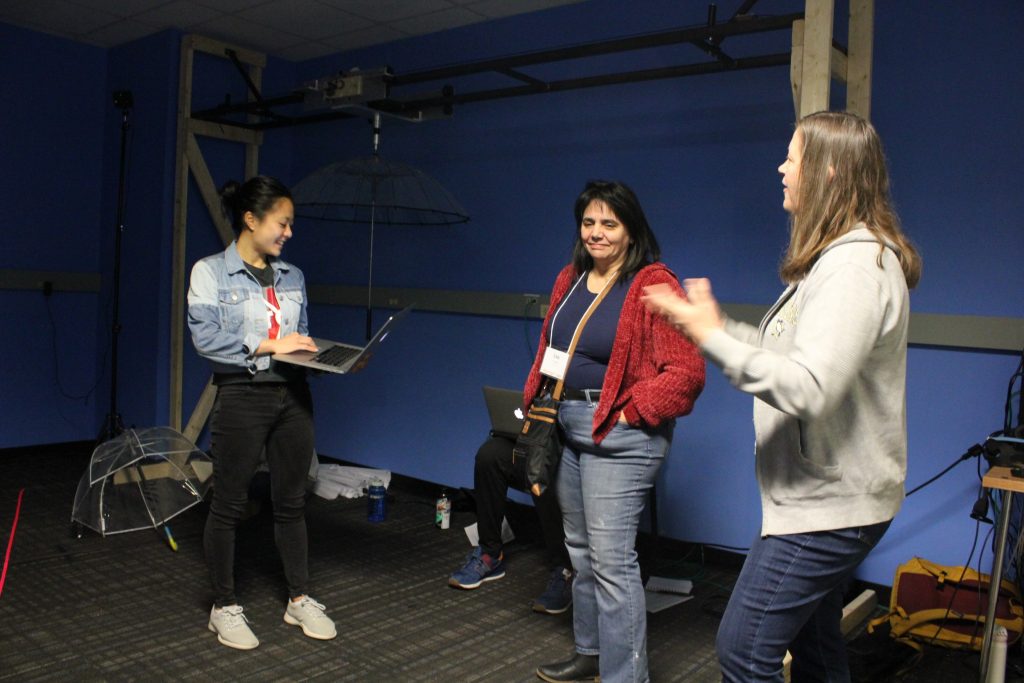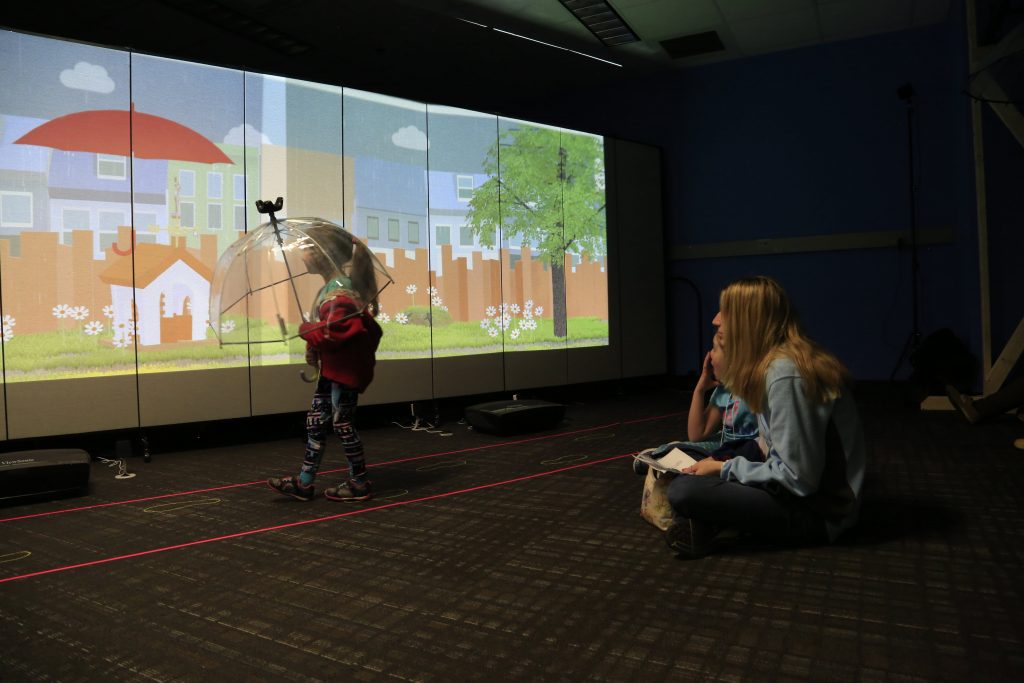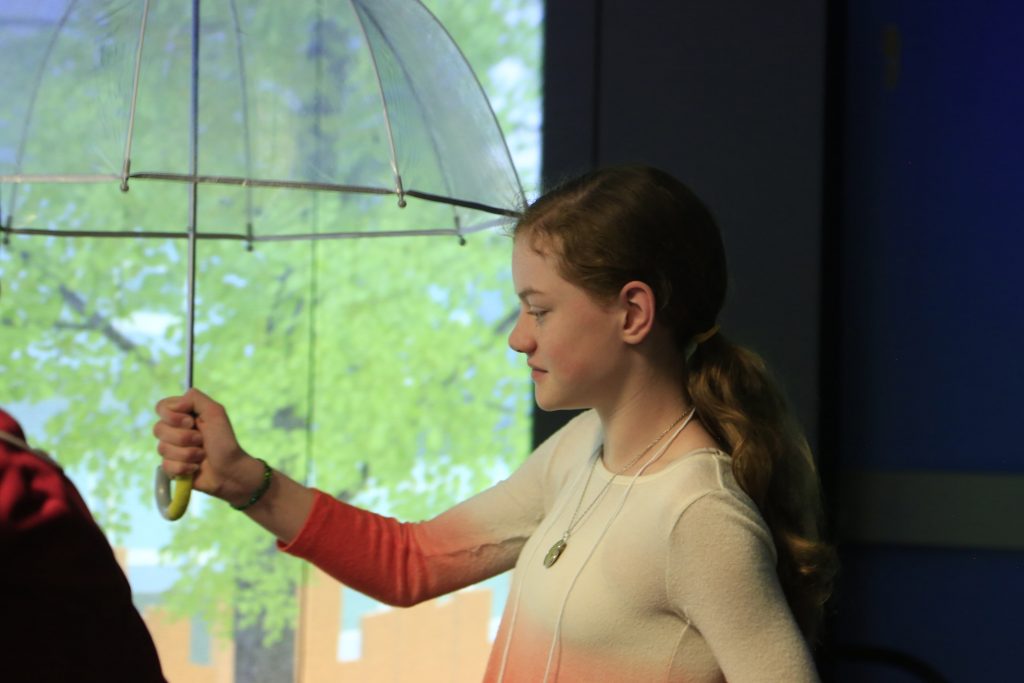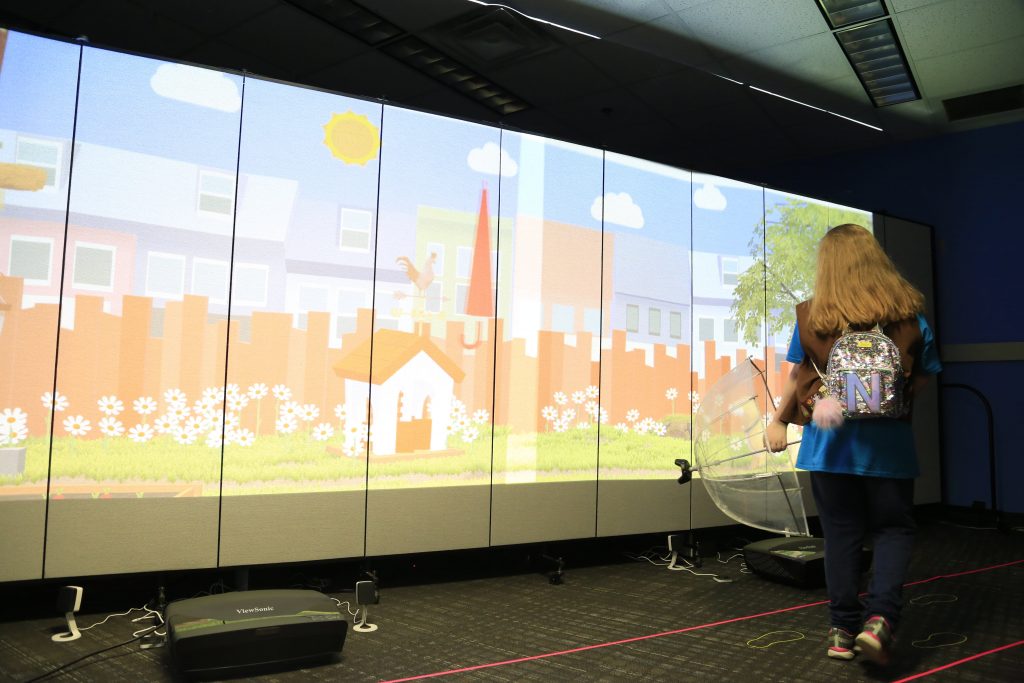Week 11
We spent this week preparing for ETC Playtest Day.
We continued to implement changes from our last playtest, working on adding in sad and happy animations for characters and more sound reinforcements.
On Monday, Heather gave our artists feedback on their models and animations. She recommended meeting with Ricardo to discuss how to fix art styles to be more consistent among the different artists. On Wednesday, Ricardo stopped by to give the artists suggestions for their assets.
In addition, we finally got our short throw projectors, allowing us to expand past 10 ft. Unfortunately, they were the wrong models so we were only able to extend to 17 ft. With this new experience, we will have to go back to playtesting with the Vive tracker and an untethered umbrella because our tethered umbrella is only at 10 ft wide.
For the ETC Playtest Day, we wanted to test the following:
- Sound reinforcement: is it necessary to have positive and negative sound reinforcement for performing acts of kindness? Or are the happy and sad animations sufficient?
- We temporarily had added in sound effects for immediate reinforcement of behavior when we didn’t have sad/happy character animations. Now that we have those character animations, we want to remove the sound reinforcement, because kindness is about acting in concern for others without the expectation of anything in return. Having successful sounds correlates to a gaming experience, and we want to stay away from gamification. So from this playtest, we want to know if our animations are enough to elicit empathy from guests to perform the acts of kindness without anything in return.
- We will test both with and without sound reinforcement.
- Pacing: is there enough time for the guests to successfully perform an act of kindness?
- Now that the experience is wider, how much time will guests need to traverse the full length the experience?
- We also shortened the sun cycle and added in a rainbow as a time counter, and we want to make sure that there is enough of a break in there to allow guests to take turns, but also allow one guest to play through multiple rounds without having to wait too long in between.
- Kindness: do guests make the correlation that the experience is about practicing kindness?
- We have heard caregivers talk a lot about how the children are being kind when they play, but we want to know what children are thinking when they play.
- We will ask follow up questions during the playtest.
- Repeatability: do guests want to play again even if the interactions occur in the same order every time?
- In our earlier builds, we had order be varied every time, however we found that sometimes the same interaction would occur back to back which looked like a glitch in the program. So we returned to a sequential experience to avoid that.
- The client has suggested varying the order in which the interactions occur in each rain cycle so that the experience seems more varied.
- We want to test how repeatable the experience is, even when the same cycle of interactions occur, and if children will get bored of it.
Overall, we had a really successful playtest day and were able to answer our above questions. In addition, our clients Allison Banks and Rebecca Grabman were able to stop by to watch our playtest and give us feedback.
Sound Reinforcment
We alternated using sound reinforcement among groups of playtesters and we found that sound reinforcement didn’t really matter. Guests who didn’t have sound reinforcement still felt that helping the characters made them feel good, and they still felt guilty if they didn’t shelter the characters from the rain. The happy and sad animations, as well as the heart effects elicited enough empathy from guests to perform the interaction.
However, our clients did like having a negative reinforcement sound because it taught guests that there are consequences to not helping others. As well, when the guest does not know what to do at the beginning of the experience, it helps to teach guests how to play.
In addition, we need to exaggerate the emotions and sounds of the dog character. Because we are so familiar with dogs and the dog is the first interactions, we need to make his animations and sounds more happy and sad to elicit empathy.
We will take out positive sound reinforcements and improve the dog sounds.

Pacing
We increased the amount of time to perform each interaction from the 10ft build, and the current pacing feels fine. Guests are able to perform all the interactions, even the younger children. The CMP Staff may have to revisit this when there is a tethered umbrella experience.
We tested the sun cycle at 10 seconds and it was just enough time. These two sisters who were playing knew to use the sun cycle as a break to take turns. It promoted a natural point to share. Especially when there were larger groups, guests would offer the umbrella to someone else during the sun cycle.
But during individual play, guests could still stay and play through multiple rounds (see Repeatability section).

Kindness
We found that our experience does actually convey the concept of kindness! When asked to describe what they were doing, guests would respond that they were being nice to the animals by sheltering them from the rain and bringing them back to their homes. Guests felt good when they helped the animals, and felt bad when they didn’t, showing that they felt empathy for the characters.
If you remember from the beginning of the semester the CMP defined the qualities of kindness as: intentionality, responsiveness, altruism, empathy, and acceptance. We found that guests were embodying the first four qualities when playing. They made a purposeful choice to help the characters without being prompted. They reacted with consideration of context (rain in this case). They showed concern for the well-being of the characters. And they emotionally understood the feelings of the characters. This was clear through post-playtest follow-up questions, and through listening to the playtesters describe what they were doing and why.
With an older group of children ages 9-11, we listened to them discuss the experience out loud. At one point, they wanted to see what would happen if they didn’t help the characters. One of the guests had to explain to the others that they just wanted to see what would happen, trying to justify his unkind behavior to others, which showed that there was also this social aspect to the experience. The guest did not want to be perceived as unkind by others.
When we asked that same group what was frustrating about the experience, one of the guests answered when the other guest didn’t shelter the characters, which again shows empathy.
From this playtest, we did feel like our guests were practicing kindness.

Repeatability
We found that our experience was very repeatable. Younger children wanted to play the experience constantly (not liking when we tried to interview them). Even though they knew what was going to occur next, they kept playing through. One little girl played through 4 times in a row, and was equally excited every round.
We found that guests notice different things every time they play. Since the experience is wider than their peripheral vision, guests notice more details the longer that they play the experience. In addition, caregivers start to notice the small easter eggs that we’ve hidden: flowers growing, the leaves falling out of the tree, etc.
We also found that since the interactions occurred sequentially, guests would teach each other how to play. So while one guest held the umbrella, another guest would comment and guide the player. This allowed for interactions among different groups.
So while we had originally wanted guests to work together to use the umbrella, we actually found that guests work together through one player and one spectator who stands further away and can notice more things happening. So we are seeing conversations between not only caregiver to child, but among children.
From this playtest, we decided not to randomize interaction order because we want to kindness behavior to be reinforced.

ETC Playtest Day was super helpful for us in answering final questions about our experience. Our clients were really happy about the results. We feel confident that we were able to achieve transformational content accuracy, which was one of our top listed grading metrics from our metrics matrix.
From here on out we will work on refining our experience: polishing textures, models, animations, and sound in time for Soft Opening.
Until then, be kind,
One Small Act